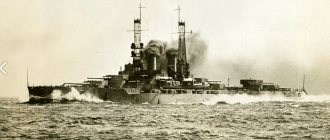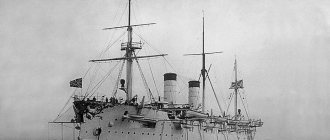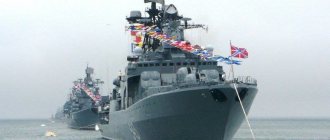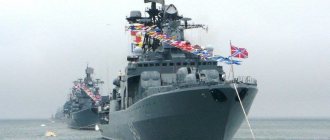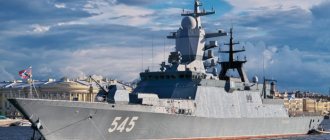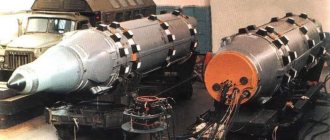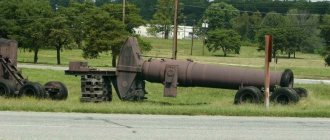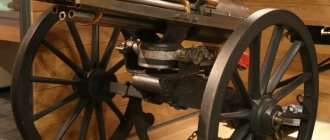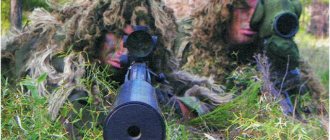It's time to talk about the apotheosis of the linear programs of Nazi Germany - the N-44 class battleships
Despite the fact that the drawings and supposed performance characteristics of this battleship are well known, there is actually nothing special to write about it. Based on the fact that this project was developed in 1944 (and this can be seen from the digital index of the project), we can safely say that this is pure alternative creativity of German designers. In reality, no one expected to build such a ship. By the way, you will find mention of this in numerous articles posted on the western part of the world wide web. And the Germans themselves considered this project only as some kind of scientific work on calculating the maximum parameters of battleships. That is, the designers tried to design a ship that would, if possible, be protected from all the threats that emerged during the Second World War and could sink any battleship that existed at that time. Whether they succeeded or not is up to you to decide. But the project was completely real and hypothetically such a ship could be built and could sail the oceans.
But let's return to the performance characteristics. So, German designers chose 8,508 mm guns as the main caliber weapon for this ship. 150 mm guns were adopted as an auxiliary caliber, and the battleship was to have 16 of them in 8 turrets, 2 per turret. There should have been the same number of universal 105 mm guns, which were supposed to protect the battleship both from aircraft and from attacks by destroyers or torpedo boats. To help them, to protect them from attacks from the air, the main enemy of battleships in World War II - airplanes, the ship, according to the project, had 16x37 mm and as many as 40x20 mm automatic rapid-fire anti-aircraft guns.
This battleship also had to receive more than impressive armor. The main armor belt should have been no less than 380 mm, the deck should have been a little less armored - 330 mm. Well, the thickness of the torpedo bulkhead should have been 45 mm.
In order not to sink at the pier, with such a serious load, the battleship of the N-44 project had unprecedented dimensions. Its length was supposed to be 345 meters. For example, the length of the largest battleship that was built, the Japanese battleship Yamato, was 263 meters. Beam - 51.5 meters (Yamato - 37) and draft 12.65 (Yamato - 10.4). With these parameters, the N-44 battleships should have had a total displacement of 141,500 tons (Yamato had 72,800).
According to the German military, battleships should not have a speed of less than 30 knots. And in order to achieve it, it was calculated that this battleship had to have a power plant with a capacity of 300,000 hp. With. By the way, in order to have a more or less normal range, it was considered advisable to equip the battleship with a combined power plant. That is, in order to develop maximum power, the ship had turbines; for all other cases, that is, the ship had to run economically on diesel engines - 4 MZ65/95 diesel engines were supposed to run on the external shafts, 1 on the internal ones TZA with the possibility of boosting.
Well, it seems that’s all according to the characteristics. In conclusion, it remains to add that it is not at all a fact that this project was even seen by any of the leaders of the Third Reich and the Kriegsmarine. In 1944, both Hitler and Dinitz were busy with more pressing problems, and they had no time for the technical “creativity” of their engineers. So, besides us, lovers of alternative history, there is essentially no one to appreciate this project.
In the period between the two world wars, very few people who were involved in the construction of warships and the management of fleets realized that such a class of warships as the battleship had actually left the scene. Perhaps only Japan and the USA understood this, and even then the stereotypes of thinking did not allow the naval commanders of these countries to completely abandon this class of warships. And as before, in all countries, super-expensive armored giants were launched into the water. Although, in linear battles, like Jutland, they will never be destined to come together.
The top leadership of the Third Reich was in exactly the same delusion. Instead of finishing the Graf Von Zeppelin aircraft carrier and building new aircraft carriers. The Germans built more and more battleships. Bismarck and Tirpitz entered service
, and behind them the Germans planned for construction a whole scattering of various battleships and battlecruisers. Apparently, Hitler was haunted by the memory of Hochseeflotte and Germany's naval power during the First World War.
| H-44 type battleships | |
| Project | |
| A country | |
| Operators | |
| Previous type | N-39 |
| Subtypes | |
| Years of construction | construction was planned for 1944-1949. (not implemented) |
| In service | Not pawned |
| Main characteristics | |
| Displacement | 150,000 t |
| Length | More than 400 m |
| Width | 51,5 |
| Draft | 13.5 + 0.5 m with additional fuel (at full displacement) |
| Booking | Main armor belt - 380 mm, Deck armor (three-layer armor in total) - 330 mm (60+140+130 mm) Anti-torpedo bulkhead - 45 mm. The thickness of the upper wall of fuel tanks is 30 mm |
| Engines | four-shaft combined steam turbine-diesel plant |
| Power | 280,000 (normal) - 300,000 (full) l. With. 4 diesel engines "MZ65/95" |
| Mover | 4 screws |
| Travel speed | 30 knots 22 under diesel |
| Cruising range | 20,000 miles at 19 knots, 25,000 miles with extra fuel |
| Armament | |
| Artillery | 8 (4x2) 508mm 16 (8x2) 150mm/65 C33 |
| Flak | 16 (8x2) 105mm/65 C33 16 (8x2) 37mm/83 C33 40 (10x4) 20mm/66 |
| Mine and torpedo weapons | 6,533 mm torpedo tubes |
| Aviation group | 6 Arado 196 seaplanes |
H-44 type battleships
(also
H-44
) - a type of unrealized German battleship from the Second World War. The super-battleship project N-44 was the last and most powerful in the N series. A series of projects N-42, N-43, N-44 were developed by a commission for new ship projects, headed by Admiral Karl Topp. The Minister of Armaments of the Third Reich, Albert Speer, created a commission to develop promising ship designs. As part of this design work, the N-series battleships were designed. In 1944, taking into account the experience gained during World War II, the N-44 was designed. The battleship was created as the most powerful and extremely protected from all threats and powerfully armed warship capable of sinking any existing enemy battleship.
Power plant [ | ]
The power plant of the N-44 battleships was planned to be mixed: 4 diesel engines and turbo-gear units with high-pressure boilers. The external shafts were to be powered by 4 MZ65/95 diesel engines. For internal shafts - 1 TPA with the possibility of forcing. All projects, starting with the N-41, had the same power plant.
K:Wikipedia:Articles without images (type: not specified)
| H-44 type battleships | |
| H-class battleship (H-class) | |
| Project | |
| A country | |
| Operators | |
| Previous type | N-39 |
| Subtypes | |
| Years of construction | construction was planned for 1944-1949. (not implemented) |
| In service | Not pawned |
| Main characteristics | |
| Displacement | 150,000 t |
| Length | More than 400 m |
| Width | 51,5 |
| Draft | 13.5 + 0.5 m with additional fuel (at full displacement) |
| Booking | The main armor belt is 380 mm, the deck armor (total three-layer armor) is 330 mm (60+140+130 mm). Anti-torpedo bulkhead - 45 mm. The thickness of the upper wall of fuel tanks is 30 mm |
| Engines | four-shaft combined steam turbine-diesel plant |
| Power | 280,000 (normal) - 300,000 (full) l. With. 4 diesel engines "MZ65/95" |
| Mover | 4 screws (4 rudders) |
| Travel speed | 30 knots |
| Cruising range | 20,000 miles at 19 knots, 25,000 miles with extra fuel |
| Armament | |
| Artillery | 8 (4×2) 508 mm |
| Flak | 88 barrels:
|
| Mine and torpedo weapons | 6,533 mm torpedo tubes |
| Aviation group | 6 Arado 196 seaplanes |
H-44 type battleships
(also
H-44
) - a type of unrealized German battleship from the Second World War. The super-battleship project N-44 was the last and most powerful in the N series. A series of projects N-42, N-43, N-44 were developed by a commission for new ship projects, headed by Admiral Karl Topp. The Minister of Armaments of the Third Reich, Albert Speer, created a commission to develop promising ship designs. As part of this design work, the N-series battleships were designed. In 1944, taking into account the experience gained during World War II, the N-44 was designed. The battleship was created as the most powerful and extremely protected from all threats and powerfully armed warship capable of sinking any existing enemy battleship.
Design
According to Groener[40]
| Design | H-39 | H-41 | H-42 | H-43 | H-44 |
| Bias | 56,444 t (55,553 long tons) | 68,800 t (67,700 long tons) | 90,000 t (89,000 long tons) | 111,000 t (109,000 long tons) | 131,000 t (129,000 long tons) |
| Length | 277.8 m (911 ft 5 in) | 282 m (925 ft 2 in) | 305 m (1,000 ft 8 in) | 330 m (1,082 ft 8 in) | 345 m (1,131 ft 11 in) |
| Ray | 37 m (121 ft 5 in) | 39 m (127 ft 11 in) | 42.8 m (140 ft 5 in) | 48 m (157 ft 6 in) | 51.5 m (169 ft 0 in) |
| Project | 10 m (32 ft 10 in) | 11.1 m (36 ft 5 in) | 11.8 m (38 ft 9 in) | 12 m (39 ft 4 in) | 12.7 m (41 ft 8 in) |
| Main | 8 × 40.6 cm (16.0 in) | 8 × 42 cm (16.5 in) | 8 × 48 cm (18.9 in) | 8 × 50.8 cm (20.0 in) | |
| Secondary | 12 × 15 cm (5.9 in) and 16 × 10.5 cm (4.1 in) | ||||
| A.A. | 16 × 3.7 cm (1.5 in) and 12 × 2 cm (0.79 in) | 32 × 3.7 cm (1.5 in) and 12 × 2 cm (0.79 in) | 28 × 3.7 cm (1.5 in) and 40 × 2 cm (0.79 in) | ||
| Torpedoes | 6 × 53.3 cm (21.0 in) | ||||
Excerpt characterizing Battleships of the H-44 type
Countess Rostova with her daughters and already a large number of guests was sitting in the living room.
The Count led the male guests into his office, offering them his hunting collection of Turkish pipes. Occasionally he would go out and ask: has she arrived? They were waiting for Marya Dmitrievna Akhrosimova, nicknamed in society le terrible dragon, [a terrible dragon,] a lady famous not for wealth, not for honors, but for her directness of mind and frank simplicity of manner. Marya Dmitrievna was known by the royal family, all of Moscow and all of St. Petersburg knew her, and both cities, surprised by her, secretly laughed at her rudeness and told jokes about her; nevertheless, everyone without exception respected and feared her. In the office, full of smoke, there was a conversation about the war, which was declared by the manifesto, about recruitment. No one had read the manifesto yet, but everyone knew about its appearance. The Count was sitting on an ottoman between two neighbors who were smoking and talking. The count himself did not smoke or speak, but tilting his head, now to one side, now to the other, looked with visible pleasure at those smoking and listened to the conversation of his two neighbors, whom he pitted against each other. One of the speakers was a civilian, with a wrinkled, bilious and shaved thin face, a man already approaching old age, although dressed like the most fashionable young man; he sat with his feet on the ottoman with the air of a domestic man and, throwing amber far into his mouth from the side, impulsively inhaled the smoke and squinted. It was the old bachelor Shinshin, the countess's cousin, an evil tongue, as they said about him in Moscow drawing rooms. He seemed to condescend to his interlocutor. Another, fresh, pink, guards officer, impeccably washed, buttoned up and combed, held amber in the middle of his mouth and lightly pulled out smoke with his pink lips, releasing it in ringlets from his beautiful mouth. This was Lieutenant Berg, an officer of the Semenovsky regiment, with whom Boris rode together in the regiment and with whom Natasha teased Vera, the senior countess, calling Berg her fiancé. The Count sat between them and listened attentively. The most enjoyable activity for the Count, with the exception of the game of Boston, which he loved very much, was the position of listening, especially when he managed to pit two talkative interlocutors against each other. “Well, of course, father, mon tres honorable [most venerable] Alfons Karlych,” said Shinshin, laughing and combining (which was the peculiarity of his speech) the most popular Russian expressions with refined French phrases. - Vous comptez vous faire des rentes sur l'etat, [You expect to have income from the treasury,] do you want to receive income from the company? - No, Pyotr Nikolaich, I just want to show that cavalry has much less benefits against infantry. Now imagine, Pyotr Nikolaich, my situation... Berg always spoke very precisely, calmly and courteously. His conversation always concerned himself alone; he always remained calmly silent while they were talking about something that had nothing directly to do with him. And he could remain silent in this way for several hours without experiencing or causing the slightest confusion in others. But as soon as the conversation concerned him personally, he began to speak at length and with visible pleasure. - Consider my position, Pyotr Nikolaich: if I were in the cavalry, I would receive no more than two hundred rubles a third, even with the rank of lieutenant; and now I get two hundred and thirty,” he said with a joyful, pleasant smile, looking at Shinshin and the count, as if it was obvious to him that his success would always be the main goal of the desires of all other people. “Besides, Pyotr Nikolaich, having joined the guard, I am visible,” Berg continued, “and vacancies in the guards infantry are much more frequent.” Then, figure out for yourself how I could make a living out of two hundred and thirty rubles. “And I’m putting it aside and sending it to my father,” he continued, starting the ring. “La balance y est... [The balance is established...] A German is threshing a loaf of bread on the butt, comme dit le proverbe, [as the proverb says],” Shinshin said, shifting the amber to the other side of his mouth and winked at the count. The Count burst out laughing. Other guests, seeing that Shinshin was talking, came up to listen. Berg, not noticing either ridicule or indifference, continued to talk about how by transferring to the guard he had already won a rank in front of his comrades in the corps, how in wartime a company commander can be killed, and he, remaining senior in the company, can very easily be company commander, and how everyone in the regiment loves him, and how his daddy is pleased with him. Berg apparently enjoyed telling all this, and did not seem to suspect that other people might also have their own interests. But everything he told was so sweetly sedate, the naivety of his young egoism was so obvious that he disarmed his listeners. "Hitler's secret weapon. 1933-1945" is a book that describes the main aspects of the development of German secret weapons in 1933-1945. This manual fully explores Germany's weapons program, from the super-heavy P1000 Ratte tank to the highly effective Seehund miniature submarine. The book is filled with various information and secret data on German weapons during the Second World War. It tells how jet-powered fighters were tested in battle and describes the combat power of the Hs 293 air-launched anti-ship missile.
In addition, the manual includes a large number of illustrative illustrations, summary tables, and battle maps.
Sections of this page:
In 1937, the Oberkommando der Kriegsmarine (OKM - High Command of the Naval Forces) ordered the start of design development of new battleships that would become successors to the Bismarck class ships. On the basis of the Bismarck, larger and more powerfully armed ships were to be created and their construction completed within the time frame determined by Plan Z.
However, from the very beginning, the work schedule began to be disrupted. Hitler's passion for gigantic projects began to create problems for designers already in the first stages of development, since he categorically demanded that the new battleships be equipped with main guns of 50.8 cm caliber, and not 40.6 cm, as the engineers proposed. With great reluctance, he agreed to reduce the caliber when it was explained to him that a battleship with 50.8-centimeter guns would have to have a displacement of 81,280 to 121,920 tons, and its length would be at least 300 meters. Ships of this size will require fundamentally new, much more massive port equipment, the design and construction of which will take much longer than the creation of traditional warships.
As a result, the design of the N-39 series battleship was approved, which was, in fact, an enlarged version of the Bismarck class ships. The most distinctive external feature of the new vessel was its double-chamber smokestacks, in contrast to the single-chamber smokestacks that were installed on all previous large Kriegsmarine warships. However, the N-39 was strikingly different from the Bismarck and Tirpitz in its “stuffing”, since it was equipped with 12 MAN diesel engines instead of the steam turbines of earlier ships. It was estimated that the use of diesel engines would increase the ship's range by 60% and allow it to reach a maximum speed of 56 km/h (30 knots), which was comparable to similar characteristics of battleships entering service with foreign navies.
The increase in space required for engines and pipes forced a revision of the layout of aircraft launching devices, such as hangars and catapults, which on the Bismarck were concentrated in the central part of the ship. It was decided to place the hangars of four Arado Ar 196 seaplanes on the aft superstructure and lay rails on both sides of the aft towers, along which the aircraft could easily be delivered to the catapult located on the centerline of the quarterdeck.
In accordance with Plan Z, the production of six battleships of the H-39 series was ordered, and contracts for their construction were awarded to several German companies:
Battleship "N": , Hamburg;
Battleship "J": , Bremen;
Battleship "K": Kiel;
Battleship "L": Kriegsmarinewerft shipyard, Wilhelmshaven;
Battleship "M": , Hamburg;
Battleship "N": Bremen.
Battleship "N" was laid down at the shipyard on July 15, 1939, and construction of battleship "J" began on September 1 of the same year. Work on the battleship K was scheduled to begin on September 15, but was postponed due to the outbreak of war. Military actions caused the freezing of construction of the first two ships, the assembly of which had already begun. At the time of the suspension of construction, of the 14,278 tons of materials ordered for the production of the battleship "N", 5,893 tons were delivered to the shipyard, but only 778 tons of this amount were used for the manufacture of the keel. Even smaller amounts of work were completed on the battleship "J", for which, of the 3587 tons of materials ordered, only 41 tons were used in the production of the keel. Already in 1940, it was decided to cancel the N-39 program in order to free up resources for the construction of submarines, as a result of which the battleships "N" and "J" were scrapped, but design research aimed at creating improved battleships did not stop.
N-40
The development of the first battleship of this series began in 1940 with a study of the possibilities of enhancing the armor of the original N-39 model. Two options were considered simultaneously, unofficially called N-40A and N-40B. Their fundamental differences from each other were that the N-40A, which had reduced combat power, was equipped with three twin 40.6 cm turret guns, which made it possible to significantly increase the armor layer without a sharp increase in displacement, while the N-40B retained the same four twin 40.6 cm turret guns, but was noticeably increased in size to ensure its reliable protection. Since the increase in weight required more power to maintain the design speed of 59 km/h (32 knots), it was decided to equip the battleship with a mixed power plant consisting of diesel engines and steam turbines, now driving not three, but four shafts. However, these were only informal studies that did not have a significant impact on subsequent models, starting with the N-41 series.
N-41
In 1941, OKM initiated official research work on the design of battleships of the future, which were to be distinguished by high speed (at least 56 km/h or 30 knots) and armor sufficient to protect against expected enemy attacks. The result of these studies was the N-41 model, which had reinforced horizontal armor and strengthened anti-torpedo bulkheads, and was also equipped with a mixed propulsion system of the 1940 models, but retained three shafts. The N-41 model was slightly larger than the Japanese Yama-to class ships, its displacement when fully loaded was 77,216 tons, and its overall length was just over 300 meters.
N-42
The loss of the Bismarck in May 1941 forced the German command to think about the problem of the vulnerability of their ships to enemy air attacks. A new series of modifications to the N-41 was developed to neutralize weak points in the protection of propellers and rudders, which were most susceptible to torpedo attacks. Proposals for safety improvements being considered also took into account lessons learned from the damage caused to the battleship Scharnhorst when it was attacked by RAF bombers in 1941. At first it was planned to make changes to the N-41 class models, but it soon became clear that the design had to start from scratch, and instead of a modified version of the old model, a new ship of the N-42 series was developed. It was equipped with four propeller shafts with shrouds to protect the side walls of the propellers and multiple rudders to provide additional maneuverability in the event of damage to the steering gear. The increase in displacement led to a deeper draft, which complicated the construction and operation of ships of this class. Already at the initial stage, the N-42 became a more massive ship than all its predecessors, and with improved armor and torpedo protection installed on it, its final length was 305 meters, its greatest width was almost 43 meters, and its displacement when fully loaded was 99,568 tons, which made it comparable in size to modern nuclear-powered aircraft carriers.
N-43 and N-44
The developments that followed the N-42 became increasingly far from reality: to destroy any possible opponents, the new ships were supposed to install eight main 50.8 centimeter guns - this caliber was the largest of all that had ever been considered for combat operations at sea. However, additional weapons and heavy anti-aircraft guns, which turned out to be unsuitable in the only military campaign of the Bismarck, did not undergo significant changes. They were supplemented only by 37 mm and 20 mm installations, the effectiveness of which against air raids was extremely limited. The N-43 project turned out to be impossible - it would be very difficult for German shipyards to build ships of this class, and testing them in closed waters would become extremely dangerous. The project illustrated purely theoretical and unfettered possibilities, much like Tillman's plans for the American "giant battleship" of 1916.
The N-44 was the last major development of large battleships, which was supposed to be equipped with enhanced protection, including multi-layer armored decks capable of withstanding bombardment by all but the heaviest armor-piercing shells. The total transverse depth of the numerous anti-torpedo bulkheads was 11 meters (twice as much as on the Bismarck), and the triple bottom was supposed to minimize the damage caused by mines. The four-shaft hybrid propulsion system was similar to that developed for the H-42 and H-43, but the increased size of the H-44 resulted in some reduction in speed, although the range remained virtually unchanged: 37,000 km (20,000 nautical miles) at 35 km/h (19 knots).
The main guns of the N-44 were identical to those designed for the N-43: eight 50.8 cm cannons on four twin turrets. Given the ever-growing threat from the air, the decision to leave the heavy anti-aircraft installations with the same ones that were equipped with the Bismarck and Tirpitz seems surprising. Smaller anti-aircraft guns became more numerous - twenty-eight 37 mm guns on twin mounts and ten 20 mm guns on quad flack-firling mounts. The increased dimensions of the H-44 made it possible to install a more spacious hangar on it, which had enough space for nine seaplanes.
O-class battlecruiser
Specifications
Displacement: standard - 32,818 tons, fully loaded - 38,813 tons
Length: 256 m
Maximum width: 30 m
Draft: 8.02 m
Engines: eight 24 cylinder diesel engines plus Brown Boveri turbines with a total output of 131,243 kW (176,000 hp)
Speed: 65 km/h (35 knots)
Range: 26,000 km (14,000 nautical miles) at 35 km/h (19 knots)
Crew: 1965 people
Armament: main - 6 x 381 mm; additional - 6 x 150 mm; anti-aircraft - 8 x 105 mm, 8 x 37 mm, 20 x 20 mm; torpedoes - 6 x 53.3 cm torpedo launchers
Armor: 190 mm along the waterline, 210 mm on the turrets
Aircraft: 4
Battleship N-45
Specifications
Displacement: standard - 492,702 tons, fully loaded - 627,843 tons Length: 609.6 m
Maximum width: 91.44 m
Draft: 16.76 m
Engines: estimated total power required - 372,057 kW (498,735 hp)
Speed: 56 km/h (30 knots)
Range: 55,595 km (30,000 nautical miles) at 37 km/h (20 knots)
Crew: 5000 people
Armament: main - 8 x 80 cm; additional - 12 x 24 cm; anti-aircraft - 24 x 128 mm plus 55 mm and 30 mm light anti-aircraft guns; torpedoes - 6 x 53.3 cm torpedo launchers
Armor: 380 mm along the waterline, 660 mm on the turrets
Aircraft: 14
Number of ships built: 0
The last word - N-45
Although the N-44 was the last design development of a new battleship, this story still had some continuation. After the loss of the Bismarck, Hitler demanded that an H-class battleship be built so huge that it could be equipped with eight 80-centimeter main guns taken from the Gustav and Dora armored trains. Had this idea been put into practice, the result could have been some kind of hulking monster. For convenience, this project was designated H-45; in terms of tonnage it would far surpass the largest modern ship - the 564,763-ton supertanker Knock Nevis.
O-class battlecruiser
The O-class battlecruisers were a key part of Plan Z and were intended to conduct combat operations against Allied convoys, which were to be carried out as part of task forces in cooperation with three H-class battleships and one aircraft carrier. The support forces were supposed to attack the escorts accompanying the convoys, giving the battlecruisers the opportunity to attack merchant ships. However, not a single O-class battlecruiser was ever built, as the creation of submarines took priority.
Notes
Footnotes
- In the Soviet Union
the class was to be armed with 40.6 cm guns.[1] - These figures correspond to John Campbell; Erich Groener states a range of 36,800 m (40,200 yd) at 30 degrees elevation, while William Hartzke and Robert Doolin give a range of 37,800 m (41,300 yd) at 33 degrees.[2][14]
- Lindemann Battery was named after the late Kapitän zur See
Ernst Lindemann, commander of the battleship
Bismarck
. - " Wotan Weich
"—"Wotan "soft" is a type of steel armor developed by the German Navy.
It had a tensile strength of 65–75 square millimeters and increased to 25 percent.” Wotan Hard
- "Wotan Hard" - was tougher and had a tensile strength of 85–96 mm.2 and expanded to 20 percent.[23] - Lützow
was lost during the battle due to uncontrollable flooding caused by severe damage to her unarmored bow.[25] - Scharnhorst
was attacked by British bombers while at La Pallice; she was hit by five bombs, each of which penetrated the ship's armored deck.[32]
Quotes
- ^ a b
Wheatley, paragraph 90. - ^ a b c d f g gram h i j k l
Groener, p. 35. - ^ a b c
Hartzke and Doolin, paragraph 311. - MaioloS. 35–36.
- Garzke and DulinS. 311–312.
- ^ a b
Hartzke and Doolin, p. 312. - ^ a b c
Wheatley, paragraph 91. - ^ a b c d f g gram hour i
Groener, p. 37. - ^ a b
Hartzke and Doolin, p. 327. - ^ a b
Collector, item 411. - Jochmann, paragraph 402.
- ^ a b
Gardiner and Chenault, paragraph 225. - Garzke and Doolin, paragraph 340.
- ^ a b c d
Hartske and Doolin, paragraph 329. - Campbell, paragraph 228.
- ^ a b c
Hartzke and Doolin, p. 331. - Garzke and Doolin, paragraph 337.
- ^ a b c d
Sturton, paragraph 48. - SturtonС. 43–44.
- ^ a b c d
Hartske and Doolin, paragraph 332. - Garzke and DulinS. 332–333.
- ^ a b
Hartzke and Doolin, p. 336. - Groener, P. X.
- Garzke and Doolin, paragraph 333.
- Groener, paragraph 57.
- Garzke and DulinS. 333–334.
- ^ a b
Hartzke and Doolin, p. 334. - ^ a b
Hartzke and Doolin, p. 335. - Garzke and DulinS. 315–317.
- ^ a b c d
Hartske and Doolin, paragraph 318. - Breuer Battleships
, item 314. - Breuer Scharnhorst
, paragraph 26. - ^ a b
Hartzke and Doolin, p. 319. - Garzke and Doolin, paragraph 320.
- Hartzke and Doolin, pp. 320-22.
- ^ a b c d e f gram
Groener, paragraph 38. - ^ a b c d e
Hartzke and Doolin, paragraph 322. - Hartzke and Doolin, paragraph 343.
- ^ a b c
Hartzke and Doolin, p. 323. - GroenerS. 35–38.
Design
Battleships of the Bismarck type served as the prototype for N-type projects. Armoring of N-44 type battleships. The main armor belt is 380 mm, the deck armor (total three-layer armor) is 330 mm (60+140+130 mm). Anti-torpedo bulkhead - 45 mm. The thickness of the upper wall of fuel tanks is 30 mm,
Armament
The main caliber of the N-44 battleships was represented by eight 508-mm guns in four twin turrets. 150-mm C28 guns (in eight twin mounts), 16 in total, were adopted as an auxiliary (mine-resistant) caliber. Anti-aircraft armament - 16 (8x2) 105 mm/65 C33 guns, 16 (8x2) 37 mm/83 C33 guns and 40 (10x4) 20 mm/66 guns. The aircraft armament consisted of six Arado 196 seaplanes[1].
Footnotes
- Breuer: Der Z-Plan
, p.3. - Wheatley, p. 90.
- ↑ and also Gröner, Jung and Maass, p. 62.
- ↑ and Hartzke and Doolin, p. 311.
- Maiolo, pp. 35–36.
- Garzke and Doolin, pp. 311-312.
- ↑ and Hartzke and Doolin, p. 312.
- ↑ and Wheatley, p.91.
- ↑ and Breuer: Der Z-Plan
, p.28. - Garzke and Doolin, p. 327.
- ↑ and The Collector, page 411.
- Jochmann, p.402.
- ↑ and Gardiner and Chenault, p. 225
- ↑ and Breuer: Der Z-Plan
, p.25 - ↑ and Hartzke and Doolin, p. 337.
- ↑ and Hartske and Doolin, p. 329
- ↑ and Campbell, p.228.
- Campbell, p.219.
- ↑ and Hartzke and Doolin, p. 331.
- Garzke and Doolin, p. 337.
- ↑ and Sterton, p. 48
- Sturton, pp. 43–44.
- ↑ and Hartzke and Doolin, p. 332.
- Garzke and Doolin, pp. 332–333.
- ↑ and Hartzke and Doolin, p. 336.
- Garzke and Doolin, p. 333
- Garzke and Doolin, pp. 333-334.
- ↑ and Hartske and Doolin, p. 334
- ↑ and Hartzke and Doolin, p. 335.
- Garzke and Doolin, pp. 315-317.
- ↑ and Hartske and Doolin, p. 318
- Breuer: Battleships
, p. 314 - Garzke and Doolin, p. 319
- ↑ and Gröner, Jung and Maass, pp. 62–63.
- ↑ and Hartske and Doolin, p. 320
- ↑ and Hartske and Doolin, p. 322
- ↑ and alsogram of the hour and Gröner, Jung and Maass, page 63
- Garzke and Doolin, p. 343
- ↑ and also by Hartske and Dulin, p. 323
